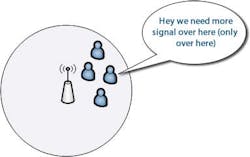I have been saying this for a little over a year now but someone finally started testing the theory that wireless beamforming (if done correctly) is really cool. Tom's Hardware has produced a great and seriously in depth article about beamforming and how it effects wireless propagation, speed and connectivity. It features Ruckus Wireless, Cisco and Aruba access points.
Traditionally omni directional onmi antennas were made of a simple material that when radiated at a certain frequency produced "signal amplification" which made your wireless signal travel farther. This worked really well but came with certain downfalls.
Wasted energy: Traditional omni-directional antennas "amplify" the wireless signal in a 360 degree horizontal pattern at all times even though most of the users may be concentrated in a smaller 90 degree quadrant. Wasted energy means less propagation.Access points (APs) equipped with beam forming attempt to overcome these two issues by creating software controlled beams of signal directed only to the client connecting at that moment.
Focuses Energy where it is needed: Instead of broadcasting the wireless signal arbitrarily in a 360 degree horizontal patterns, directional high ghain beams are formed and aimed at the client connecting to the access point. More concentrated signal means better propagation, better performance and a fewer number of access points.As the article states the technology is in its infancy but is gaining ground and being used more and more in complex wimax antenna arrays as well as indoor 802.11a/b/g/n access points. When perfected this will allow us to build more reliable indoor and outdoor wireless IP video surveillance networks and what a wonderful world that would be.
-Ronen Isaac WLANmall.com & Continental Computers





